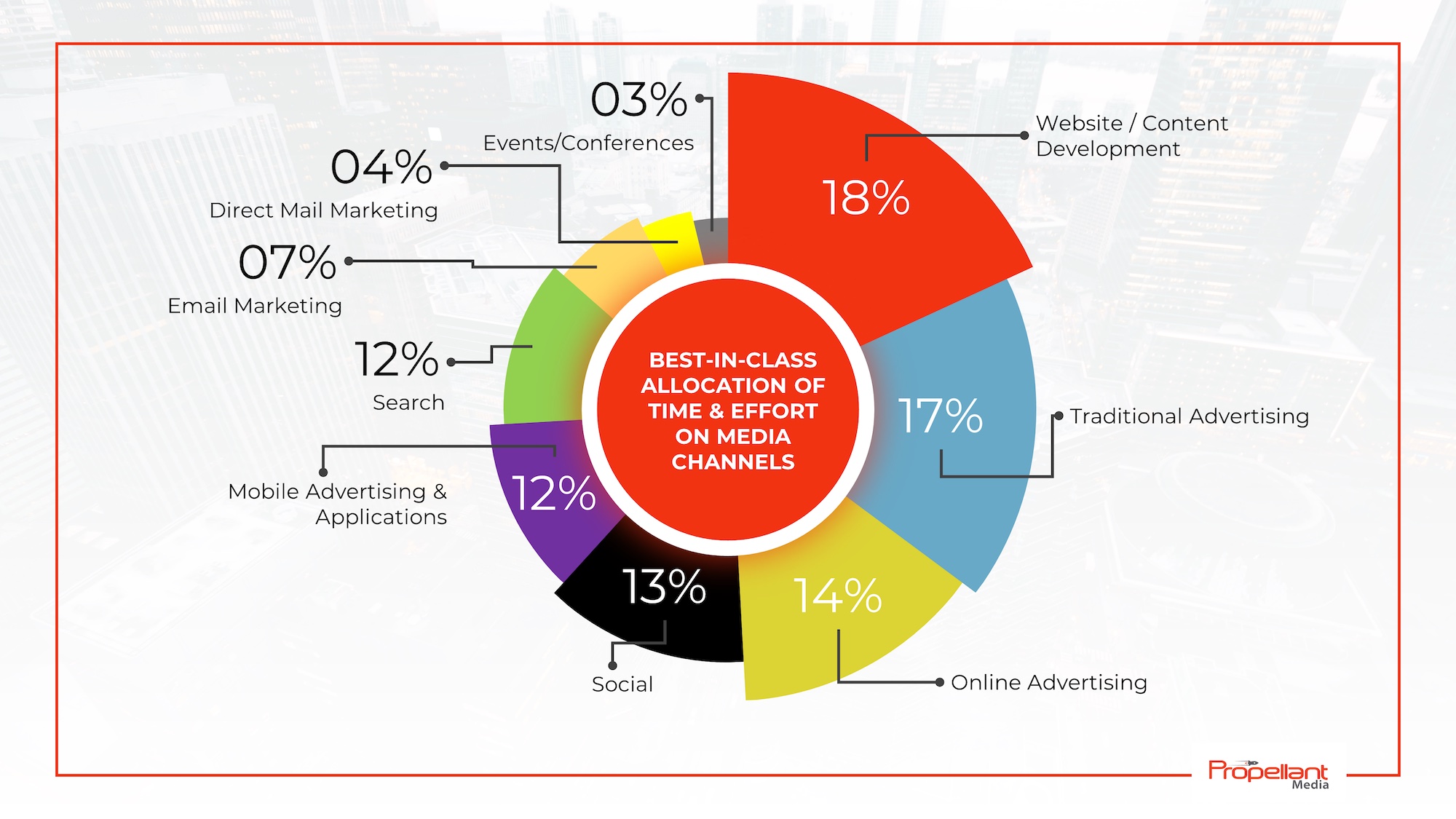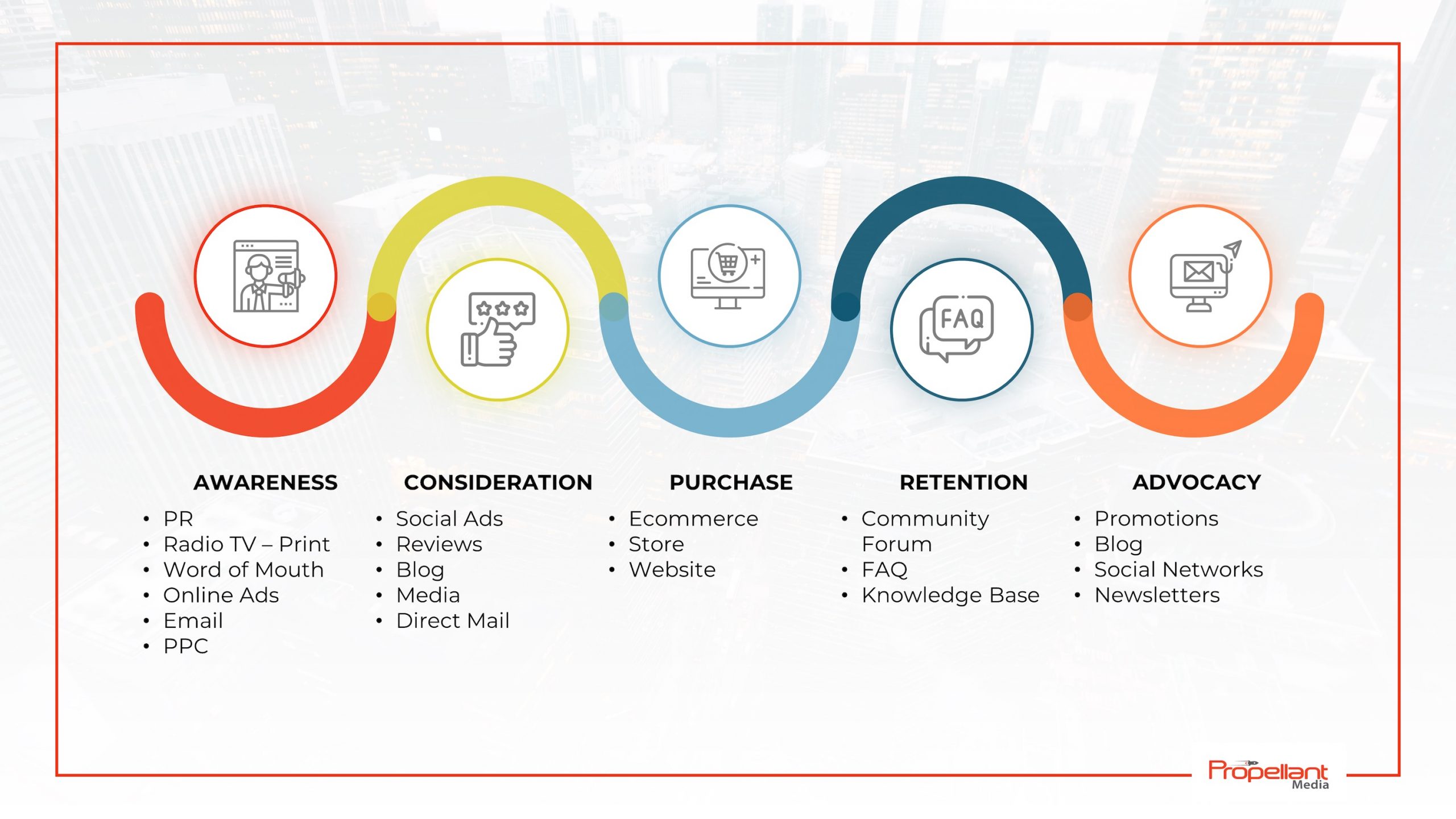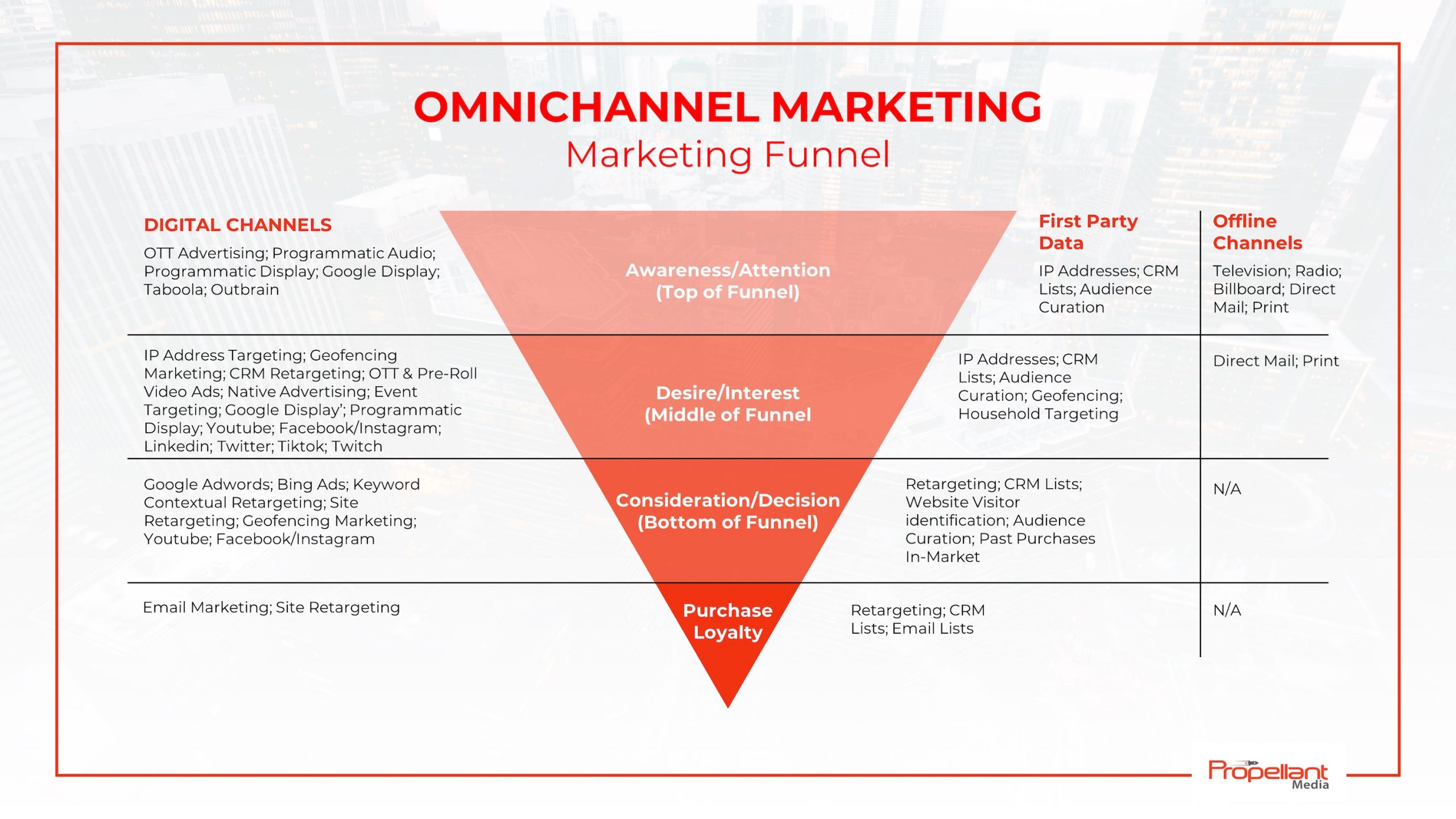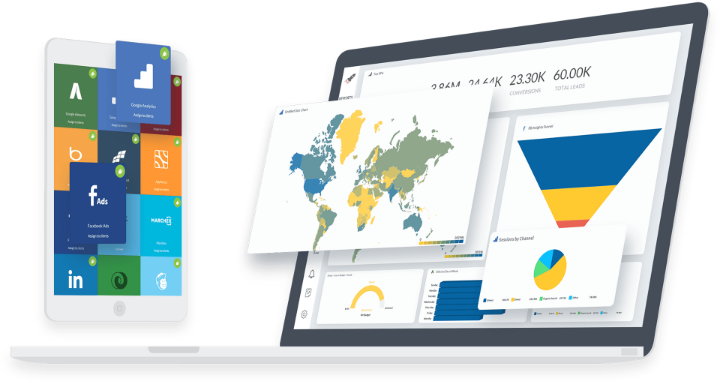Oftentimes, brands and agencies dig deep into specific advertising channels such as Google Search, Paid Social, Direct Mail, TV, and others with no cohesion between them all, let alone choosing to advertise across multiple channels. Rarely do they think about developing an omnichannel strategy that will fuel more engagement, more leads, and more sales versus cherry-picking specific channels to start with.
Brands put up a website, add content, hear about one particular marketing channel, and then hit go. But the customer experience lives beyond just one channel. It lives beyond one device. It even lives beyond one stage of the purchase funnel of that customer. Customers migrate between their mobile, laptop, tablet, and now big-screen devices. They may spend only one minute on Google while spending one hour on Facebook. They may then read a news article on a third-party website such as CNN. And then, that same consumer may be watching a TV show on their streaming device. We’ve identified over 16 possible touch points for a brand to hit that consumer, and we haven’t even touched them after reaching the brand’s website. Depending on the length of the customer journey, only doing Google Ads or Facebook alone won’t cut it. Neither will TV Advertising or Radio. It’s omni-channel advertising that gets brands the type of engagement and conversions that translate into sales and growth.
In this guide to omni channel advertising, we walk through the strategy and the opportunity for brands (big and small) to use more comprehensive omnichannel marketing plans to drive engagement and how all the channels fit into your marketing puzzel.
Here are some of the top Digital Channels For Omni Channel Advertising we’ll be discussing in greater detail:
- Google/Bing/Yahoo Search
- Paid Social (Facebook/IG/LinkedIn/Twitter)
- Programmatic Display
- Geofencing Marketing
- OTT Advertising
- Site Retargeting
- Search Engine Optimization (SEO)
- Email Marketing
- Conversion Rate Optimization
And of course, you cannot forget the offline channels, and even though we won’t go into greater detail here, we will touch on these secondary channels:
- Television
- Radio
- Direct Mail
- Billboard
What Is Omni Channel Marketing
Omni channel marketing is the practice of utilizing multiple digital online and offline marketing channels to reach customers throughout their purchase journey AND creating a unified customer experience with the consumer at the center of the experience. Each decision for the various marketing channels are integrated into the others with optimized spend levels, personalized messaging across all channels depending on the purchase stage of the consumer, and a seamless experience for the customer that allows for all channels to talk to one another. Also known as cross-channel marketing, omni-channel marketing makes it easy for customers to complete desired conversions on whatever medium they are most comfortable with.
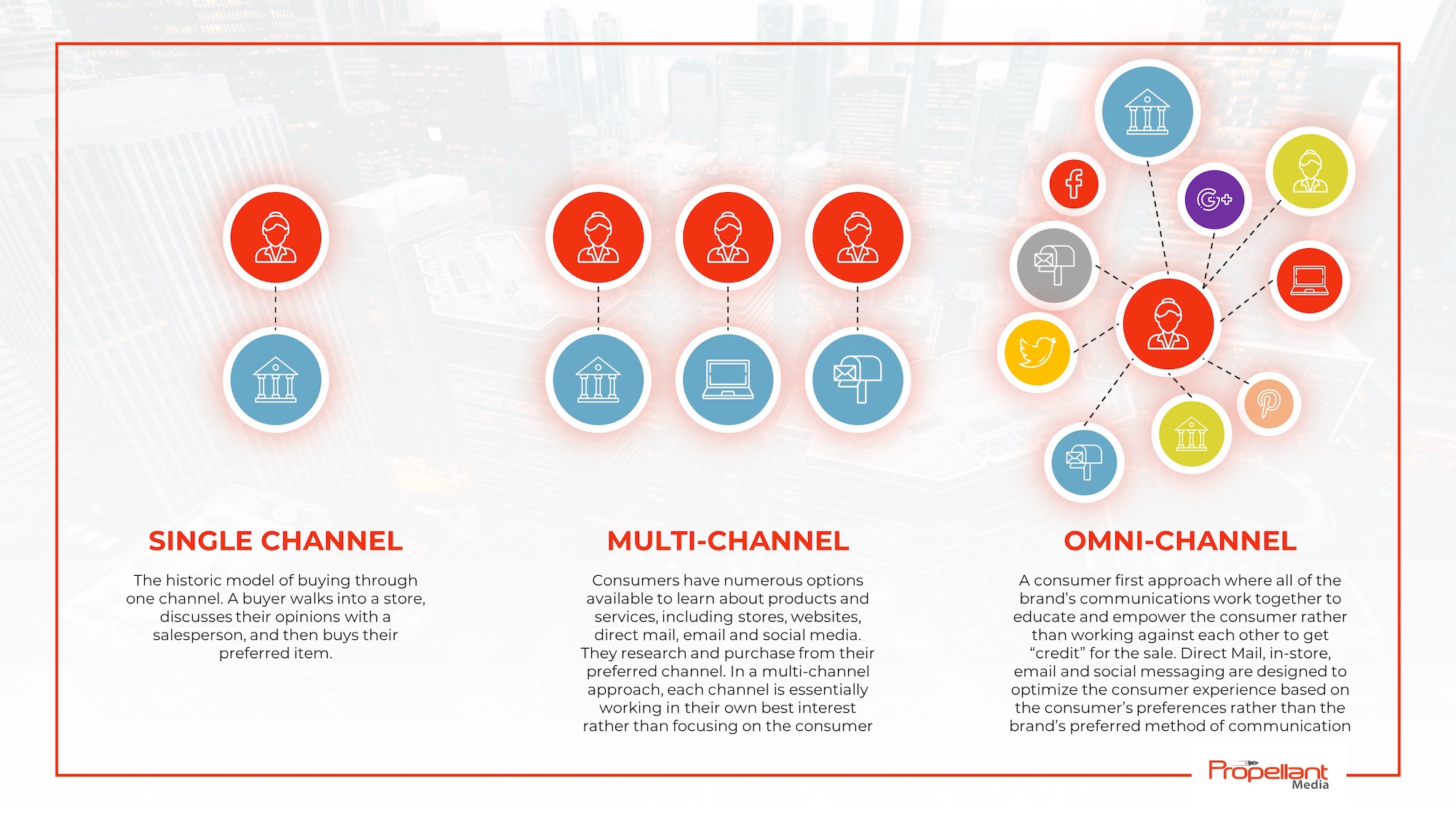 This is different of course from single channel marketing and even multi-channel marketing which is illustrated above. We discuss the clear advantages of omni channel marketing, but the graphic above shows the true opportunity with omni channel versus single or even multi channel advertising.
This is different of course from single channel marketing and even multi-channel marketing which is illustrated above. We discuss the clear advantages of omni channel marketing, but the graphic above shows the true opportunity with omni channel versus single or even multi channel advertising.
Multichannel vs. Omnichannel Marketing
While omni-channel and multichannel seem similar on the surface, they have major differences that affect the way customers view your company. Omnichannel focuses on those small details to bring unity to your digital channels. Customers recognize this unity and appreciate it.
Multichannel marketing focuses on launching campaigns across multiple channels, but those channels do not really speak to one another. The creative for one channel is not in concert with the creative ads for another. For example, you only set up campaigns that allow for you to reach people on Google Adwords, but don’t retarget those same people on Facebook or Instagram or even YouTube for that matter.
Many shoppers today are beginning their path to purchase on one device and ending it on a different one, or starting online and completing the sale in-store and vice versa. A growing array of modern technology formats, combined with the accessibility of store locations, means products are only a few taps, steps, or miles away. Digital channel, device, and distance no longer dictate purchase behavior. Today’s shopper is comfortable searching and buying across a variety of formats and locations.
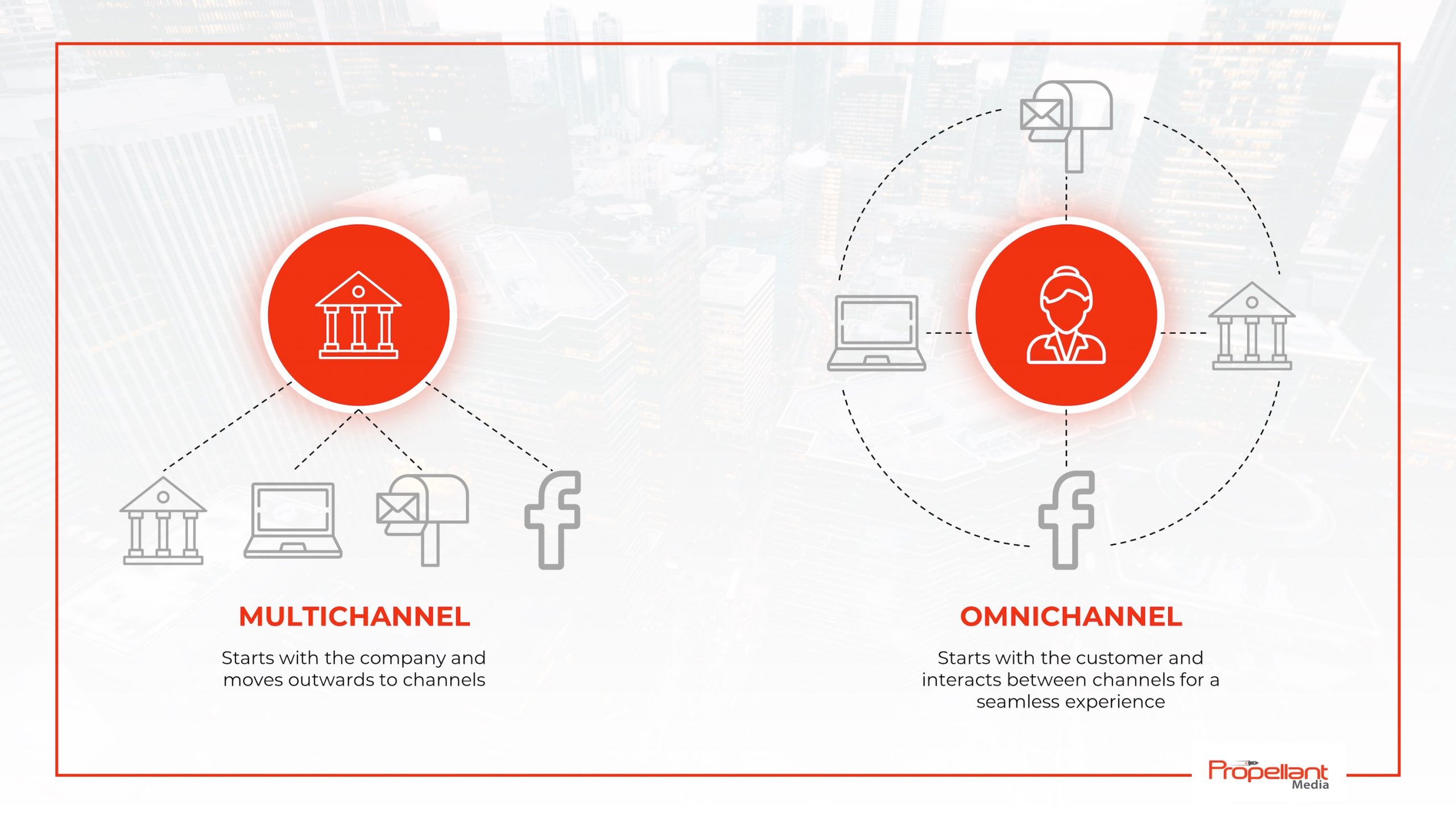 Omnichannel marketing has the customer at the center. They focus on the needs of the customer, providing them with a personalized message in a seamless, unified experience. This allows for brands to touch the consumer multiple times without experiencing ad fatigue.
Omnichannel marketing has the customer at the center. They focus on the needs of the customer, providing them with a personalized message in a seamless, unified experience. This allows for brands to touch the consumer multiple times without experiencing ad fatigue.
Benefits of Omnichannel Marketing
Brands that choose to advertise via specific digital channels are losing out over benefits of omni channel advertising. It’s still possible to have positive ROI and successful marketing via one of a few marketing channels, but the benefits of omni channel marketing far outweigh the challenges.
Better Data Collection & Analysis
With omni channel marketing, the data collection and analysis is better. Typically, by focusing on one channel, you have less opportunity to collect information and data on the path your customers are going through prior to the purchase stage. And finally, when they do purchase you are then given more background on the journey they went through. Instead of dealing with customer data across disparate channels, you can get a 360 view across multiple channels and use that intelligence to inform and present data to your teams.
Better Customer Segmentation, Campaign Designs & Targeting
Analysis of your customer data will allow for more powerful customer segmentation and even better targeting. First, you can better determine how to create more effective creative designs based on where people are in the purchase stages and how that matches up with each marketing channel. Second, if you know someone purchased a car already, no need to retarget them with more car offers. That then allows you to save money by not targeting the same users who purchased from you. Customer segmentation and omni channel advertising will give you perspective on which channel produced that sale so you can both shut it off for that customer, and then think about new designs and offers to cross sell and up sell to the same customer.
Achieve Higher ROI & ROAS
We traditionally see brands achieve higher ROAS and return on investment than those that are very channel specific. We can take Propellant Media as the perfect example. We have customers visit us via Adwords, SEO, Facebook, and even LinkedIn channels. But we retarget across all of them as well as Programmatic Display. That level of retargeting makes our first touch channels work smarter and covert better in addition to building the sense of authority to the prospect visiting our website.
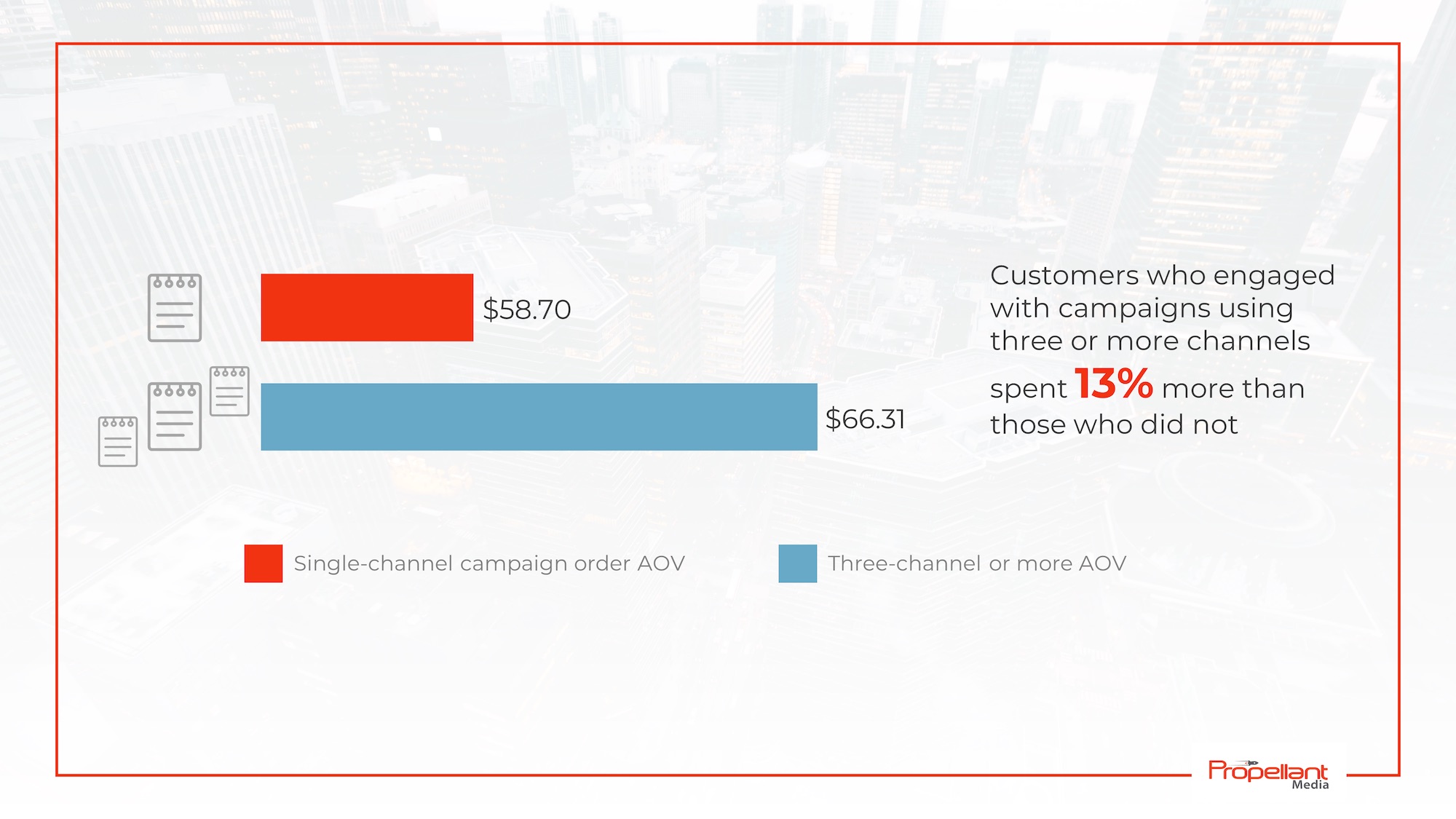 Chance To Mitigate Your Marketing Risk
Chance To Mitigate Your Marketing Risk
We at Propellant Media consider focusing on one exclusive digital channel to be marketing malpractice. When you pick several channels to start with, you are then able to spread your marketing dollars around a bit more and then reallocate based on which channels are producing more conversions and sales for your brand. Similar to Google Adwords, you won’t launch a campaign with five keywords only. You target many more because you don’t know which ones will produce results. The same logic holds true for omni channel marketing.
Quick Opportunity To Pivot
When you are focused on one channel, there’s not a lot of opportunity to pivot your marketing dollars. If Facebook is your only channel and it doesn’t work, you’re in a tough spot. But when you start with multiple channels, you can use learning from all channels to pivot a lot more quickly and scale to the channels bearing more fruit for your brand.
Better Visibility For Your Brand
Lastly, omni-channel advertising creates great visibility for your brand by showing your brand across multiple channels. It’s an obvious statement, but far too often we see brands taking their ad spend to Google Search and maybe a little bit of site retargeting. But did you know a searcher on Google’s platform only spends a max of 60 seconds searching an answer to their query? You are then missing out on the other audiences who consume content on platforms such as LinkedIn, Facebook, Instagram, and the many Programmatic Channels you can expose your brand on.
Developing Proper Omni Channel Strategy For Any Industry
It requires more than a 5,000 page guide to discern how to develop strategy for any brand, let alone an omni channel marketing strategy. But there are a few tenets that makes for developing that omni channel marketing plan a bit easier.
Understand The Customer Journey
Typically, businesses and enterprises exist to fulfill a need, answer a question, or solve a major problem. And those individuals can have those three things determined by finding the answer OR someone pressing the answer upon them…as if they didn’t know they had that need to fulfill, or the question they didn’t know needed answering, or the problem they didn’t even know they had. This is at the heart of the customer journey. Knowing where that customer is going to research, find, and discover the answers to those questions helps brands pick where and how best to advertise.
So the major question we have for brands developing an omni channel strategy is, “Where are your customers going to fulfill that need, answer that question, or solve that problem they have?” And there are both online and offline channels those consumers go to answer those three things. You can discover this by reviewing your own Google Analytics, your own Point of Sale Data for e-commerce brands, industry market research, and even putting yourself in the shoes of your buyer and determining where you’d go to research and make an informed decision.
That thought process will lead you to creating amazing process sheets, thought bubbles, and ideas on how best to reach your consumer.
Develop Your Buyer Personas
Not every message is for only one type of buyer. The 33-year old mother who is buying a minivan has a different purpose than the 44-year old man who is looking to buy the same minivan. Both warrant different messages and more importantly both consume content and get their questions answered across different media channels. Thus, developing these personas will allow you to cultivate a clear understanding of where to go to answer that question, how to communicate effectively with those individuals, and finally how to build a cohesive strategy that places the consumer at the center of the omni channel marketing experience.
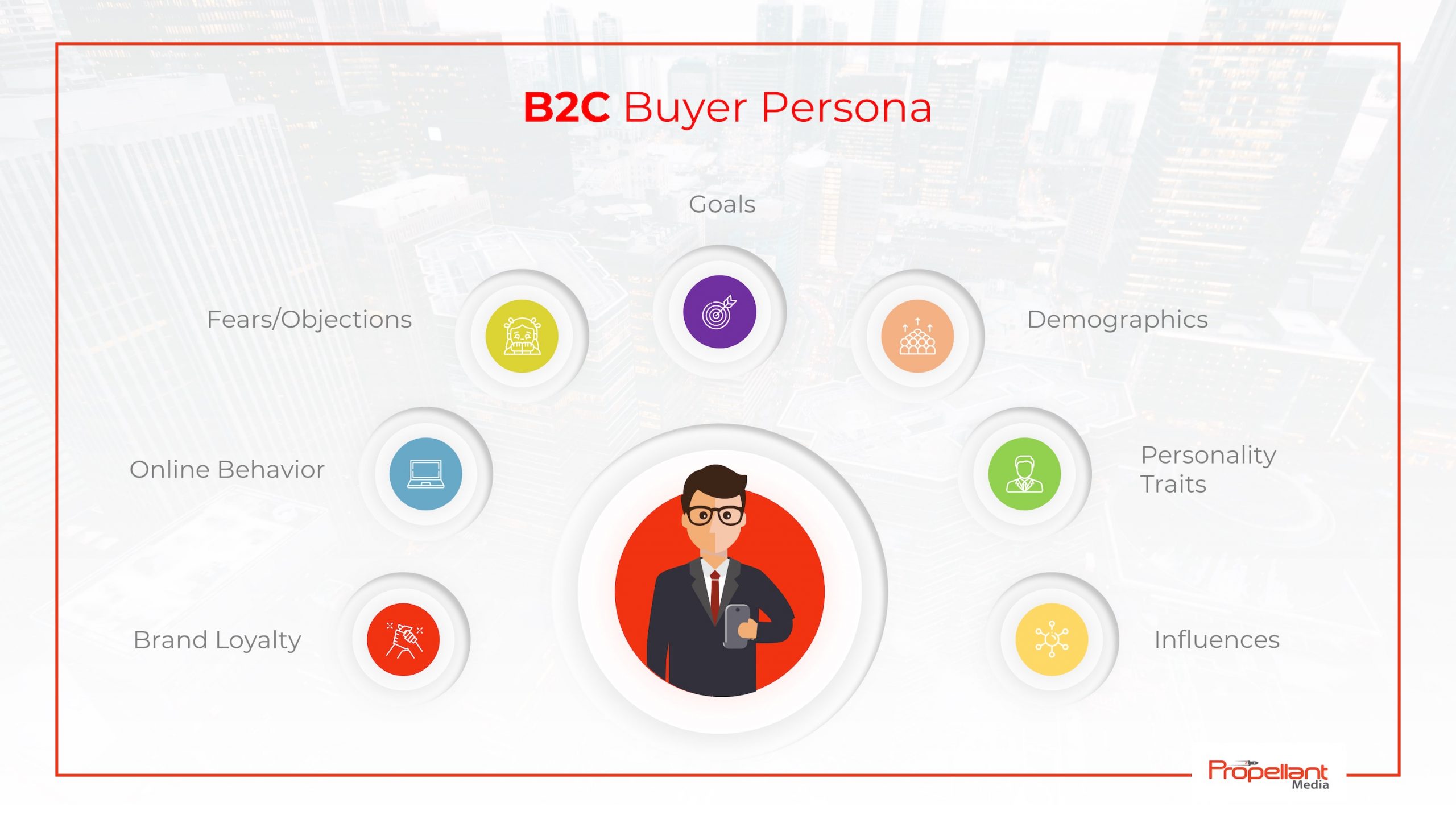 We won’t go into how to develop personas, as there are many out there to help accomplish that, including this article here by HubSpot.
We won’t go into how to develop personas, as there are many out there to help accomplish that, including this article here by HubSpot.
Conduct Your Competitor Research
Nothing better than researching how your competitors are performing and where they’re advertising. It’s fool’s gold to not know who your competitors are and the more important intimate details on each of them. It’s not easy to locate where they are advertising, but there are a plethora of tools including SEMRUSH, AHREFS, SpyFU and other industry leading tools as well. Also, a free tip is to conduct simple Google searches so you know the full list of direct competitors in your geographic set. It’s important to understand the messaging, pricing, and unique offerings from your competitors.
Choose Digital Channels
Now the fun begins. Determine the digital channels you want to serve your ads on. We discuss in greater detail, but as you develop your media plan, think through the low, mid and high cost online and offline marketing channels and begin to use your perspective on which ones will produce the most fruit.
Measure Measure Measure
Set up tracking in every way you possibly can. Whether you are using Pardot, Google Analytics, Hubspot or your Analytics tool of choice, you must set up goal and conversion tracking. We have a section where we talk specifically about how to measure success across your omni-channel digital campaigns, but this is absolutely vital to omni-channel marketing success.
Ideal Omni Channel Digital Channels To Start With
Most of these channels are understood by brands and enterprises looking to devise an omni channel marketing plan, but understanding where they fit within the marketing funnel (Top – Awareness, Middle – Consideration, Bottom – Decision) will help you determine how to best to allocate your initial spend levels.
Here are some of the top digital channels for omni-channel advertising:
- Google/Bing/Yahoo Search – Considered the bottom (decision stage) of the funnel, this is some of the best traffic while also some of the most expensive traffic you can get your brand in front of. These are individuals actively searching for an answer or solution to their query. They spend on average less than 60 seconds on Google/Bing/Yahoo, so this is some of the most attentive traffic you can get in front of and likely the highest converting traffic.
- Google Display – Google’s Display network can range from top to bottom of funnel buyers who may be targets for the right audience but that audience isn’t necessarily in market for your product or service. At the same time, one can leverage possible in-market audiences and keywords that happen to be on specific landing pages, giving advertisers some perspective on where the consumer is in the purchase journey. Google Display is great for middle-of-funnel targeting.
- YouTube/Pre-Roll Video – Video can range from top of funnel all the way to bottom of funnel. We’ve ran several lead generation campaigns that are reaching consuming who are in market, including the new YouTube Lead Form tactic. And, given YouTube is the second largest search engine behind Google, it does provide for a middle to bottom of funnel strategy for brands.
- Paid Social (Facebook/Instagram/LinkedIn/Twitter) – All the way from top to bottom of the funnel, paid social provides for targeting in-market audiences to those who possess specific customer demographics and psychographic characteristics. The unique opportunity with LinkedIn is the B2B advertising advantage. We drive a ton of leads for education brands in the world. The same thing goes for Facebook and Instagram. We’ll build look alike models to reach top converters from LinkedIn and Google and feed that data into Facebook and IG for better omni channel targeting.
- Programmatic Display – Programmatic is powerful channel, and a critical one that tends to impact all other channels. With programmatic display and the multitude of tactics ranging from geofencing marketing and keyword contextual to CRM retargeting and site retargeting, you can reach people from top of funnel to the bottom of funnel.
- Geofencing Marketing – Geofencing marketing is a powerful practice within the programmatic advertising family of targeting specific buildings, homes, and locations based on a person’s physical presence inside that location. So depending on the industry, geofencing can be a very powerful bottom of funnel tactic (car dealerships are a great example here) and all the way up to top of funnel.
- OTT Advertising – OTT Advertising is another new kid on the block that can overtake and supplement pre-roll video as well traditional TV advertising. Mostly top to middle of funnel, it can be incredibly powerful given the attention you are garnering from cord cutters. The other advantage is the ability to combine specific audience targeting opportunities with OTT Advertising that you don’t get from traditional TV advertising. The other advantage with OTT Advertising is we can measure online and offline actions such as walk-ins to your store or physical location.
- Site Retargeting – We have to separate this out as its own tactic given it can be listed in Google Display, Programmatic, Facebook/Instagram, and even LinkedIn. It’s one of the best omni channel tactics brands can implement. So much so, we developed a guide to site retargeting that you can find here. This is closer to bottom of funnel and possibly middle of funnel targeting.
- Search Engine Optimization (SEO)– Another crucial area of marketing that can lend itself to increased organic traffic, this can range from the top of the funnel all the way down to the bottom of the funnel depending on your keyword strategy, the content you’re producing, and the publicity your brand is getting.
- Email Marketing– Another tactic that is not typical of traditional paid media advertising, but a vital one that can reach middle to bottom of funnel buyers. This tactic is absolutely critical to the omni channel strategy you cultivate for your brand. Oftentimes, people don’t buy when they come to your site, and those that do…there are more opportunities to keep those buyers engaged. Email marketing accomplishes that at a lower cost than any other channel.
- Conversion Rate Optimization – Another tactic that has more to do with converting people who come to your website or your brand for that matter. But this must also be factored into your omni channel marketing plan as it helps create a cohesive user experience and lowers your cost per conversion across all your digital and even offline marketing channels.
You cannot forget about those offline channels, which too can have an impact on top of funnel awareness building. Oftentimes, we see brands utilize these tactics to drive people through the purchase funnel. The key is leveraging data and audience intel to ensure you’re reaching the right customers who are more prone to purchasing from you. Here are the Secondary Offline Channels to take into consideration:
- Television
- Radio
- Direct Mail
- Billboard
We don’t focus as much on those offline channels. The key with media buying for offline channels is knowing where your audience frequents, strong creative and messaging, timing, and budget allocation. As long as those tenets are at the forefront, your offline buying can maintain that omni channel strategy you want to deploy and tie back into your online marketing efforts.
3 Best Practices For Each Digital Channel
This requires a totally different guide, but we wanted to furnish a few best practices in each channel as a means to give brand managers and team a headstart on developing and executing an omni channel marketing plan.
Google/Bing/Yahoo Search
1. Create tiers of keywords at the brand awareness, consideration, and decision stages.
2. Focus on broad match modifier and exact match keywords. This helps limit waste and and unwanted terms that drive up costs to your brand.
3. Initially, start with the Google Search network instead of their search partners.
Google Display
1. Utilize In-Market Audiences, as these are audiences who could be in-market for similar products and services
2. Use Custom Audience that Cross Over into other audiences. This is similar to using boolean logic to target say women between ages of 25 – 50 AND also are researching keywords related to your products or services.
3. Use site retargeting across the google display network, but limit the ads served per day per person.
YouTube/Pre-Roll Video
1. Use more site retargeting via the YouTube network as well as pre-roll programmatic display networks
2. Consider using YouTube lead forms. Similar to Facebook Lead Forms, this is a new tactic rolled out by YouTube that tends to drive lead flow
3. Further, define your targeting with audience parameters on YouTube
Paid Social (Facebook/IG/LinkedIn/Twitter)
1. Test out all the social media platforms, as you never know which one will produce the desirable ROI
2. Leverage site retargeting across all paid social channels
3. Set up multiple ad sets & ads in FB/IG. This helps tie optimization and performance faster and gather better intelligence
Programmatic Display
1. Again, use site retargeting across programmatic display channels
2. Leverage geofencing marketing to reach people in very specific locations like competitor buildings or places your audience frequents
3. Leverage keyword contextual targeting to reach people who are in-market researching your products or services
Geofencing Marketing
1. Target competitors at buildings who are in-market for your products and services
2. Set the audience pool to 2 weeks to a full month. This allows you to reach your target audience at a good time without wasting impressions and ad spend.
3. Set up conversion zone tracking so you can measure walk-in visits to your physical location if you have a brick and mortar store.
OTT Advertising
1. Utilize addressable household geofencing with OTT advertising to tie stronger audience data to the power of OTT advertising.
2. Stick to 15 – 30 seconds instead of 60-second commercials.
3. Build campaigns that speak to each buyer persona. Meaning don’t build out one creative that fits all. Consider 2 – 3 creative for reaching your core audience segments given the audience targeting capabilities within the OTT Advertising world.
Site Retargeting
1. Leverage multiple digital channels for site retargeting to create a more cohesive omni-channel marketing experience
2. Set frequency caps to 3 – 4 ads per day per person to extend the reach
3. Use separate creative for individual stages of the funnel & landing pages
Search Engine Optimization (SEO)
1. Research key topics & write about things related to the typical FAQ’s centered around your business and your offering. We use platforms such as AHREFS and Google Keywords Planner, but the keyword research is vital to drive content and seo traffic to your brand.
2. Go for publicity for the brand. This means that if you have a unique story, you should work with a publicist or news platform to get more noticed. This impacts search engine optimization.
3. Consider utilizing more video and even transcribe your video content. This will will not only humanize your brand, but also drive more organic traffic from other search engines such as YouTube.
Email Marketing
1. Tie buyer personas to segmented email campaigns. Platforms such as HubSpot and Active Campaign help achieve this level of segmented and personalized messaging.
2. Use automation based on website actions. Meaning, if someone performs an action on your website, you can even have an email sent to them eliciting an action.
3. Add a video to personalize your emails. This adds a personal touch and increases open rates and conversions
Conversion Rate Optimization
1. Push your critical conversion actions to the top of the funnel and above the fold when someone first lands on your website. This includes a form, phone email, email button, purchase button, or other conversion button.
2. Create a downloadable guide/discount code, etc…. At Propellant Media, we use this strategy to add value to prospects before they ever become a customer or client.
3. Add a video to personalize your brand. No use in hiding behind the corporate veil. Adding video adds more personality and provides more context around people behind the scenes.
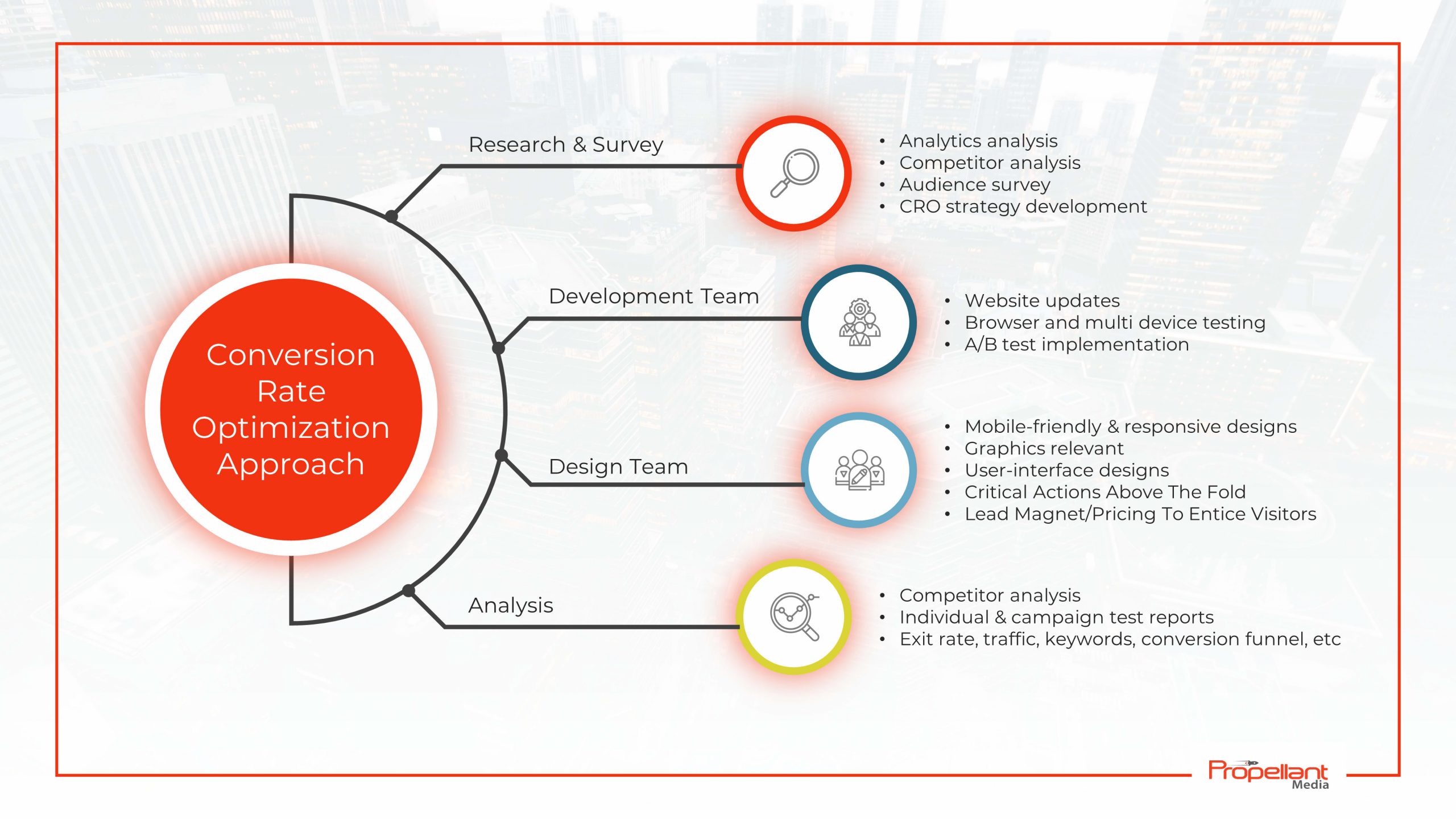 Creative Best Practices For A Cohesive Omni Channel Experience
Creative Best Practices For A Cohesive Omni Channel Experience
We utilize a litany of best practices to ensure creative ads are cohesive and match both the audience as well as the messaging across multiple channels. At Propellant Media, we say there are 3 things that matter: who are you reaching, what are you saying to them when you show up, and then where are you sending them to buy. The “What are you saying to them” matters especially when devising an omni channel strategy.
Utilize Multiple Ad Sizes For Each Digital Channel
Aside from Google Adwords and Bing Ads, which is traditionally text ads, many of the other digital platforms can take multiple ad sizes based on IAB inventory standards. So sizes ranging from 300 x 250 and 320 x 50 to 1080 x 1080 and 300 x 600, you can ensure your ads are showing up in more places based on the sizes available per each of those digital channels.
Test Out At least 2 – 3 Versions From The Beginning
By starting out with at least 2 – 3 ad versions, you give yourself more opportunities to test additional copy and, most importantly, optimize toward the creative that is performing the best. In addition, this allows for the use of the best performers to build out additional creatives that leverage those top performers. Don’t start split testing in the middle of the campaign. Campaigns need time to breathe, and utilizing multiple versions from the onset will allow for measuring omni-channel marketing and campaign performance from the onset of launching your campaigns.
Build Out Messages For Each Individual Audience
Remember the buyer personas we discussed in the beginning? Consider building out creative that is specific to each individual buyer persona. This ensures your messaging is highly personalized and custom to the audience you want to get your message directly in front of.
If You’re Using Video, 15 & 30 Seconds Max
Consumers on YouTube, Pre Roll Video, Social Media, and certainly OTT Streaming devices are not engaged with video creatives beyond 30 seconds. So keeping your creatives to 15 seconds and even 30 seconds is a best practice you should devise for your campaigns.
Not Simply “We Exist” Ads
Simply telling the world you exist as a business or brand is not enough. “Hey, we’re this great furniture store” may let people know you exist and may move the needle a bit. But people need to understand why they should connect with your brand. The buyer persona exercise will help in creating the proper ad copy here. It will also allow for greater click-through rates and strong engagement.
Add Location/Number/Website Occasionally
Whether you run a physical store or want to drive awareness or leads via your website, occasionally adding your location, phone number or website url can drive branding and brand recall. Sometimes, adding the physical address can add familiarity and make it easier for people to locate you if they want to visit your store.
Add Promotions & Benefits To Copy
Similar to the “We Exist” point above, persuadable ad copy truly moves the needle. Be sure to add promotions, value, price discounts, etc.. to your ad copy to give your potential customers a reason to engage with you.
Omni-Channel Marketing Examples
Let’s take a look at a few omnichannel marketing examples where the brands were able to implement successful omnichannel marketing strategies and drive positive results.
Target’s Partnership with Pinterest
In a strategic partnership, Target joined hands with Pinterest to integrate Pinterest’s Lens into their app. This allowed users to use their smartphones to capture a photo of something they like, and the Target app would immediately show them a similar item available in their store. This was the first time Lens was integrated into a different brand’s app.
Using this omnichannel marketing strategy, Target was able to increase their sales by almost 10%. Partnering with Pinterest as the only channel may work for your business as well if all the other social media channels have not produced any results for your brand.
Sephora
Sephora offers a consistent brand experience in all its brick-and-mortar locations with beauty tips, free makeovers, informed salespeople, and products to try. The brand also provides a consistent experience for online customers by allowing them to use their Beauty Bag accounts to track purchases, see tutorials, scan items while being at a physical store, keep a wish list, and much more.
This omnichannel strategy has allowed the brand to improve the rate of customer satisfaction, leading to a significant boost in customer loyalty. Moreover, the consistent brand experience has caused a 100% increase in mobile orders for Sephora.
Bank of America
Omnichannel marketing is not just for the retailers. Even fintech companies have used it over the past few years to offer a seamless customer experience, whether it is an ATM withdrawal, online transaction, or physical bank transaction. Bank of America (BOA) is a great example of the successful usage of an omnichannel experience.
From serving free Wi-Fi and seamless bank transactions while waiting in a branch to offering tablets as the customers sit in a kiosk with a bank manager – BOA has improved the way customers interact with the bank. They even went the extra mile and started the “Robo-branch” initiative where the customers didn’t have to wait for a teller to get free. Instead, they can share their complaints or grievances with a machine.
A holistic omnichannel approach toward marketing can allow your business to create multiple ways to deliver the same content and consistent brand experience to your customers, just like the brands mentioned above. As you may realize, a successful omnichannel marketing strategy is the one that works best for your business.
Sales & CRM Email Automation Strategies To Fuel Growth
So your customer has seen your Ads everywhere. They’ve submitted their contact details. Maybe they made a purchase or became a formal lead. The sales and CRM email marketing you implement are just as important as the initial advertising and inbound marketing tactics you deploy. There are tons of guides to implementing sales and CRM email automation campaigns, but here are a few recommendations we suggest:
Automate The Email Experience
We’ve seen brands launch all of these omni-channel marketing plans, collect purchase and contact details, and not have any email automation set up. Your email marketing is similar to your site retargeting. It is the lowest cost tactic to deploy and yet produces the highest ROI. Automating this process frees you up to focus on other things versus having to remember to send a new email to each person who submits their contact details. For those B2B and even B2C enterprises, you can utilize some software platforms like HubSpot, send a sequence of emails to an individual until they finally reply to your email, and the sequence will stop, thus not annoying the customer. So email and CRM automation is vital to your omni-channel marketing strategy.
Segment Out Your Emails To Match Your Buyer Personas
Here at Propellant Media, we have customer inquire about Pay Per Click (Paid Search) and some inquire about geofencing marketing. We have automated emails segmented for each buyer list to ensure we’re serving the right information to the needs that our potential customers have. Brands and enterprises must do the same to improve the overall effectiveness of the campaigns that are deployed.
2 – 3 Emails Every Week
Not a perfect system, but we suggest 2 – 3 emails per week is ideal…especially if that person has not purchased or scheduled an appointment with someone from your team.
Give your Customers As Many Opportunities To Convert
In your email, you have to give them a chance to buy from you or schedule the appointment. This isn’t an exercise in sharing news articles with the buyer. Provide them with opportunities to convert so you’re improving your overall conversions to your website and purchase intent with the brand.
Add Value To Your Customers
Lastly, your email copy can’t simply be… “please buy from me or schedule an appointment!” You need to bring value to your customers if they’re willing to either buy or provide their contact details. This means giving them pricing on the front end versus using it as a carrot to require an appointment or sharing an ebook that makes them more knowledgeable. Something that brings them value will translate into more purchases and conversions for your brand.
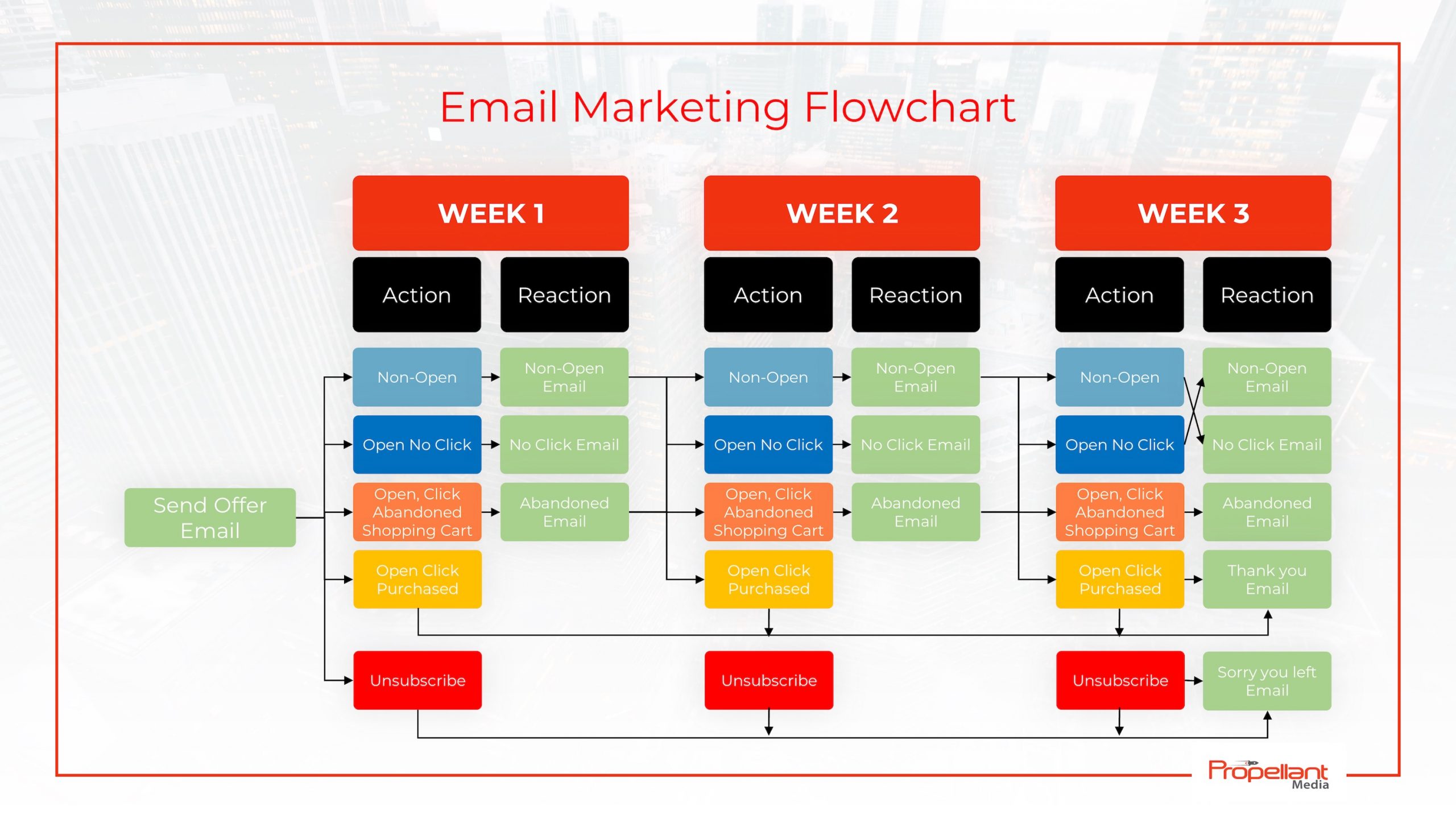 Measuring Success & Analytics Across Omnichannel Tactics
Measuring Success & Analytics Across Omnichannel Tactics
Instead of going through the details on how to measure success across all of your omni channel marketing campaigns, we will provide six best practices we try to implement across all clients implementing an omni channel marketing strategy.
Determine Your Top Conversions & Measure Them
Maybe it’s a purchase, button click, lead form, phone call, or even walk-in visit if you’re measuring walk ins from geofencing marketing campaigns. Whatever it is, notate those conversions and assign values to each of them. This will help you as you set up conversion tagging and tracking via all your digital channels.
Utilize Google Tag Manager
Google Tag Manager is a platform that allows you to not only tag your website, but to measure and control all the HTML and JAVASCRIPT needed to measure all the actions taking shape on your website. This also allows you to place all your conversion tags, site retargeting tags, and other tagging measures needed to ensure you are tracking success across your digital channels.
Set Up Goal Tracking In Google Analytics
An often missed opportunity, but an important one. Whether it’s through Google Tag Manager or directly via Google Analytics, you can set up goal tracking and measure more directly via Google Analytics. Measuring the data doesn’t have to be perfect, but this will give more insights into the trends of conversions and which channels are producing conversions as well as the top funnel conversion paths consumers are going through.
Measure Phone Calls
Our tool of choice is CallRail. Others that exist include Mongoose Metrics, Call Source, and even Marchex. Whichever you decide, you should set up call tracking in order to more effectively measure phone calls coming into your brand. With CallRail, you can even start measuring form submissions within the callrail platform and record phone calls as well. But whatever you do, set up call tracking so you have a more accurate depiction of your lead flow from the various digital channels.
Tie In Your POS/Purchase Data To Your CRM
By tying your purchase data back to your CRM and omni channel dashboard, you can then even more accurately measure sales across all your digital channels. From Google Adwords to Facebook, plenty of ecommerce brands are already doing this. But this is the most accurate way to understand your ROAS across all your digital channels.
Tag & Add UTM’s To All Of Your URLs
Adding UTM’s helps ensure you’re even more accurately measuring where your leads and which channels are producing such leads. We leverage a tool like the GA URL Tagging Tool. And you can breakdown your urls with the source, medium, campaign name, content, and even ad name/version. We use this tagging to build out dashboards with accurate data on which channels all the way down to the ad level are producing results for brands.
Set Up Your “GOD” Dashboard View To Track Everything
We call it God View because it’s your mothership of a dashboard that tells you everything about all your campaigns. Our tools of choice include TapClicks, Google Data Studio, and Tableau. Whichever you choose to utilize, you must have a dashboard that pulls all your data into one view for your marketing team and even an executive report for the executive team to view overall performance.
Conclusions Around Omni Channel Marketing
Of course, the final stage of the process is truly ongoing. It’s looking at the strategy you devised, your creative, your budget allocation, your campaign set up, your conversion and website tracking/tagging, and your dashboard/reporting. This will help you optimize and measure performance across all your channels and reallocate the budget each month. Just because your bottom of funnel tactics are producing the most conversions doesn’t mean you should automatically or even in absolute terms stop or pull back on your middle to top of funnel tactics. Brand recall and brand impact matters. We often see it with programmatic display, which drives people to lower funnel tactics.
With everything you’ve done thus far, you can optimize your campaigns against:
- Digital Channel/Source
- Medium
- Ad Copy/Creative
- Keyword
- Device
- Network
- Geography
- Website Conversion/Landing Page
- So much more….
This set up gives small to large brands a fighting chance to optimize across the proper digital and even offline channels versus putting all their eggs in only one or two offline/online marketing channels.
Frequently Asked Questions
What Are the Four Pillars of Omni Channel Marketing?
The four pillars of omnichannel marketing are:
- Visibility - A comprehensive view of customer interactions across different channels
- Measurement - Quantifying the success of the omnichannel strategy
- Personalization - Tailoring experiences to individual preferences
- Optimization - Refining the omnichannel strategy and budget based on performance insights
What Are Some Common Challenges in Omni Channel Marketing?
Some of the common omnichannel marketing challenges are as follows:
- Establishing a connection between online and offline data
- Lack of attribution due to ineffective campaign tracking
- Maintaining brand consistency across various channels
- Keeping the pricing of products and services consistent across all channels
- Measuring the wrong KPIs
- Lack of visibility into their inventory across channels
- Siloed supply chain process
- Poor order fulfillment process
- Channel conflicts
How Can We Measure Omni Channel Marketing Success?
In order to measure the effectiveness of your omnichannel marketing efforts, you need to check the major KPIs. Evaluate the number of customer interactions. This includes the number of clicks on links, the number of website visits, the number of emails sent, and the number of social media posts. This KPI can measure the success of a marketing campaign and track customer engagement.
What Role Does Customer Data Play in Omni Channel Marketing?
Brands use customer data for omnichannel marketing to better understand the past activities of the customers and their present behavior. It also allows them to predict the future needs and wants of customers. Omnichannel data can also be used to improve product/service recommendations used in upselling and cross-selling strategies. In other words, customer data helps businesses develop more effective and personalized omnichannel marketing strategies.
What Is the Role of Mobile Marketing in an Omni Channel Strategy?
Mobile device communication is essential for the success of an omnichannel marketing strategy. Mobile channels offer a unique opportunity for retailers to capitalize on consumers due to the high penetration rate of mobile devices all over the world. Mobile channels offer the consumer convenience and versatility. Mobile marketing has also improved the way retailers engage consumers through loyalty programs. Moreover, mobile marketing is improving inventory management for retailers, ensuring faster delivery of products and a more efficient tracking system.

